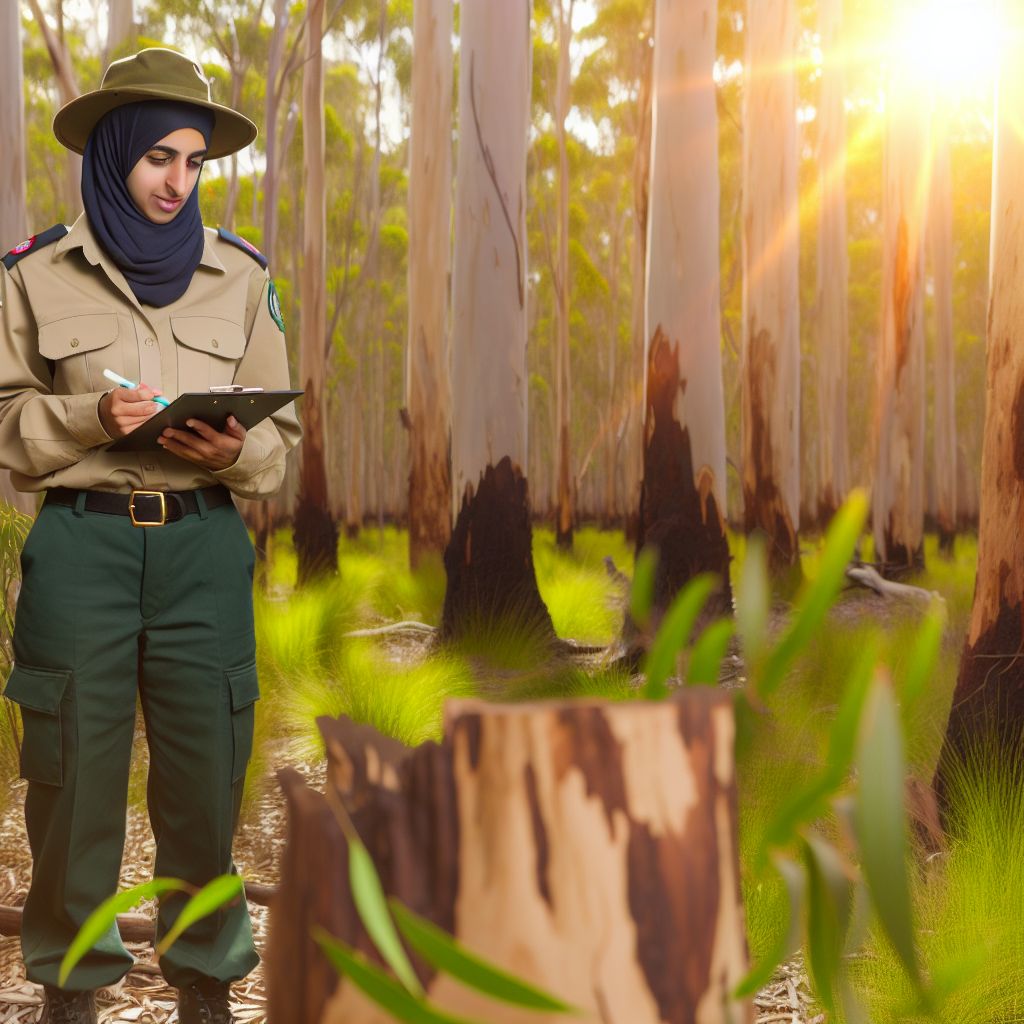Overview of the Role and Responsibilities of a Forestry Officer in Australia
Core Duties in Woodland Management
A forestry officer actively manages Australia’s woodland areas to ensure sustainability.
They monitor tree health, growth, and biodiversity within forested regions.
Additionally, they oversee the implementation of conservation plans to protect native flora and fauna.
They regularly assess the impact of logging activities to maintain ecological balance.
Moreover, forestry officers develop strategies to prevent and manage forest fires effectively.
Collaboration and Stakeholder Engagement
Forestry officers work closely with local communities and indigenous groups to respect cultural heritage.
They coordinate with government agencies to comply with environmental regulations and policies.
They also collaborate with environmental organizations to promote reforestation initiatives.
Furthermore, they engage with researchers to incorporate scientific insights into forest management.
Use of Technology in Forest Monitoring
Modern forestry officers utilize satellite imagery and drones to monitor vast woodland areas.
They employ geographic information systems to track changes in forest cover and health.
Such technology enhances precision in mapping and resource allocation efforts.
Regulatory and Reporting Responsibilities
They ensure compliance with state and federal forestry laws to protect natural resources.
Forestry officers prepare regular reports detailing forest condition and management activities.
These reports assist policymakers and support transparency in environmental stewardship.
Your Personalized Career Strategy
Unlock your potential with tailored career consulting. Get clear, actionable steps designed for your success. Start now!
Get StartedEducation and Community Outreach
They educate the public on the importance of sustainable forestry practices.
They lead workshops and field tours to raise awareness about woodland conservation.
Through outreach, they foster community involvement in protecting Australia’s forests.
Key Skills and Qualifications Required to Become a Forestry Officer
Educational Background
A bachelor’s degree in forestry is essential.
Alternatively, environmental science or natural resource management degrees apply.
Many employers prefer candidates with advanced degrees in related fields.
Continuing education helps forestry officers stay current with new techniques.
Moreover, specialized certifications can boost job prospects and expertise.
Technical and Practical Skills
Forestry officers must have strong knowledge of ecology and forest ecosystems.
They should be proficient in using geographic information systems (GIS) and mapping tools.
Additionally, skills in data collection and analysis are crucial.
Effective use of forestry equipment and technology enhances their daily work.
Physical and Outdoor Abilities
A high level of physical fitness is necessary to work in challenging outdoor environments.
Forestry officers often hike long distances on uneven terrain.
Stand Out with a Resume That Gets Results
Your career is worth more than a generic template. Let us craft a resume and cover letter that showcase your unique strengths and help you secure that dream job.
Get HiredThey also need to endure varying weather conditions with resilience.
Consequently, physical endurance supports the practical demands of the job.
Communication and Interpersonal Skills
Clear communication is vital for educating the public and collaborating with teams.
Forestry officers must write detailed reports and maintain accurate records.
They need to interact effectively with stakeholders, including landowners and policymakers.
Hence, strong interpersonal skills facilitate conflict resolution and teamwork.
Problem Solving and Critical Thinking
Officers analyze complex environmental data to make sustainable decisions.
They must anticipate challenges like pest outbreaks or fire risks.
Creative problem-solving skills help balance conservation with resource use.
Furthermore, they adapt management strategies to changing ecological conditions.
Legal and Regulatory Knowledge
Understanding environmental laws and forestry regulations is mandatory.
Forestry officers ensure compliance with local, state, and federal policies.
They often participate in enforcement and inspection activities.
This knowledge supports sustainable management and protects public resources.
Transform Your LinkedIn for Maximum Impact
Elevate your professional brand with a LinkedIn profile that attracts recruiters, showcases your expertise, and maximizes opportunities. Stand out in your industry with a profile built for success.
Boost ProfilePassion for Conservation and Sustainability
A strong commitment to environmental stewardship drives their motivation.
Forestry officers advocate for preserving biodiversity and natural habitats.
This passion encourages proactive efforts to manage woodlands sustainably.
In turn, it helps safeguard forests for future generations.
Relevant Experience and Training
Field internships and volunteer work provide valuable hands-on experience.
Employers look favorably on practical training in forest management techniques.
Continuous professional development workshops enhance skillsets.
Experienced mentors often guide new forestry officers in their careers.
Daily Tasks and Fieldwork in Managing Australia’s Woodlands
Monitoring Woodland Health
A forestry officer begins the day by assessing the overall health of the woodlands.
They observe tree growth.
Officers look for signs of disease.
They check for pest infestations.
In addition, they record data on soil moisture and nutrient levels to track ecosystem conditions.
Regular health monitoring helps prevent significant damage.
This practice supports sustainable woodland management.
Conducting Field Surveys
Field surveys are essential to gather detailed information about flora and fauna.
Forestry officers use GPS devices to map tree locations.
They identify habitat areas.
Moreover, they collect samples and document biodiversity to evaluate ecosystem diversity.
These surveys guide decisions related to conservation and woodland regeneration.
Implementing Fire Management Practices
Forestry officers play a vital role in planning controlled burns to reduce wildfire risks.
They collaborate with fire management agencies to schedule and safely conduct burns.
During fieldwork, they monitor weather conditions and fuel loads to ensure effective burn outcomes.
This practice maintains ecological balance.
It protects both woodlands and nearby communities.
Engaging with Local Communities
Officers regularly visit local landowners and indigenous groups to discuss woodland care.
They provide educational resources on sustainable land-use and wildfire prevention.
Furthermore, officers listen to community concerns.
They incorporate feedback into management plans.
This collaborative approach fosters stronger stewardship of the woodlands.
Maintaining Infrastructure and Equipment
Forestry officers inspect and maintain fencing, signage, and walking trails within woodland areas.
They also ensure that fieldwork equipment, such as GPS units and sampling tools, remain in good condition.
This upkeep is crucial for both safety and efficiency during daily operations.
Subsequently, it helps officers respond promptly to emerging environmental challenges.
Learn More: How Horticulturists Shape Australia’s Gardens and Green Spaces
Techniques and Tools Used for Sustainable Forest Management
Forest Inventory and Monitoring
Forestry officers regularly conduct detailed forest inventories to assess woodland health.
They use advanced satellite imagery to monitor changes in forest cover over time.
Additionally, drones help capture real-time data from hard-to-access areas.
These techniques allow precise tracking of tree growth and species distribution.
Moreover, field surveys complement technological tools to verify satellite observations.
Selective Logging and Regeneration Methods
Forestry officers like Matthew Jennings practice selective logging to minimize ecosystem disruption.
This method involves harvesting mature trees while preserving younger growth.
Subsequently, natural regeneration is encouraged by protecting seedlings and saplings.
In some cases, reforestation efforts include planting native species such as eucalyptus.
Such approaches ensure the long-term sustainability of woodland resources.
Fire Management Techniques
Controlled or prescribed burns reduce fuel loads and limit wildfire risks.
Fire ecologist Emma Harris collaborates with forestry teams to implement these burns safely.
They carefully plan timing and location to protect wildlife and soil health.
Furthermore, firebreaks are established to contain potential wildfires effectively.
Ultimately, these measures maintain the natural fire regimes essential for many Australian forests.
Use of Geographic Information Systems (GIS)
GIS technology helps map forest boundaries and critical habitats accurately.
Forest manager Lucas Walker utilizes GIS to analyze spatial data for management decisions.
This system supports identifying vulnerable species and habitat corridors.
It also assists in planning sustainable harvesting zones and access routes.
Therefore, GIS enhances strategic planning and conservation efforts.
Community Engagement and Indigenous Knowledge Integration
Forestry officers actively engage local communities in forest stewardship programs.
They collaborate with Indigenous custodians to incorporate traditional ecological knowledge.
This knowledge guides fire management, species protection, and land use planning.
Community involvement promotes shared responsibility and sustainable outcomes.
Consequently, partnerships strengthen the resilience of Australia’s woodlands.
Adoption of Eco-Friendly Technologies
Field staff use electric and low-emission machinery to reduce carbon footprints.
Remote sensing devices track environmental variables like soil moisture and temperature.
Data from these tools improves adaptive management under changing climate conditions.
Such innovations support sustainable practices while safeguarding forest ecosystems.
These technologies provide vital support for forestry officers’ conservation goals.
Learn More: The Role of Beekeepers in Supporting Pollination and Agriculture
The Importance of Biodiversity Conservation in Forestry Practices
Maintaining Ecosystem Health
Biodiversity plays a crucial role in maintaining healthy forest ecosystems.
It supports natural processes such as nutrient cycling and soil formation.
Moreover, diverse species improve ecosystem resilience to pests and diseases.
Therefore, forestry officers like Liam O’Connor emphasize preserving native flora and fauna.
They adopt practices that protect habitat diversity within woodland areas.
Supporting Wildlife Habitats
Forests provide essential habitats for a vast range of animal species.
Conserving biodiversity ensures that these species have suitable living conditions.
For example, Emma Harding, a forestry manager, designs buffer zones to protect sensitive wildlife.
These zones reduce disturbance from logging and human activity.
Consequently, populations of native birds, mammals, and reptiles can thrive sustainably.
Enhancing Forest Productivity and Sustainability
Biodiverse forests often have higher productivity and stability over time.
Different tree species contribute various resources and structural complexity.
Michael Byrne, an ecologist, notes that mixed-species stands resist environmental stress better.
Furthermore, biodiversity helps maintain soil fertility and water regulation capabilities.
These benefits make sustainable timber production achievable on council-managed lands.
Implementing Biodiversity-Friendly Forestry Techniques
Forestry officers implement selective logging rather than clear-cutting methods.
This approach preserves key habitat structures and minimizes ecological disruption.
They also promote the planting of native species to restore degraded areas.
Additionally, regular monitoring helps assess conservation success and informs management adjustments.
The collaboration between GreenLeaf Forestry Services and local Indigenous rangers enhances these efforts.
Community Engagement and Education
Educating local communities about biodiversity strengthens conservation outcomes.
Sarah Mitchell, a community liaison, organizes workshops and field days.
These activities raise awareness about the value of protecting woodland species.
Moreover, public involvement encourages stewardship and long-term commitment.
Ultimately, collaborative management ensures the sustainable future of Australia’s woodlands.
Learn More: AgriTech Revolution: How Technology is Shaping the Future of Australian Farming Careers
Challenges Faced by Forestry Officers Including Climate Change and Bushfires
Impact of Climate Change on Woodlands
Forestry officers observe shifting weather patterns across Australian woodlands.
These changes affect tree growth cycles and species distribution significantly.
Moreover, altered rainfall impacts soil moisture and forest health directly.
Consequently, officers must adjust management plans regularly to adapt.
They collaborate with climatologists to predict future woodland conditions accurately.
Bushfire Management and Prevention
Bushfires pose a persistent threat to Australian woodlands and ecosystems.
Forestry officers actively engage in fire risk assessment throughout the year.
They implement controlled burns carefully to reduce fuel loads effectively.
Additionally, officers coordinate with firefighting agencies during bushfire emergencies.
This teamwork ensures faster response times and better containment of fires.
Dealing with Pest Infestations and Disease Outbreaks
Climate change increases the vulnerability of trees to pests and diseases.
Forestry officers monitor woodlands frequently for early signs of infestations.
They apply integrated pest management strategies to control outbreaks sustainably.
These methods emphasize reducing chemical use while preserving forest ecology.
Balancing Conservation with Economic Demands
Officers must balance sustainable timber harvesting with ecosystem conservation.
They evaluate environmental impact assessments before approving any logging activities.
Furthermore, they promote community awareness about sustainable forestry practices.
This approach supports both local economies and healthy woodland preservation.
Addressing Changing Community Expectations
Public interest in environmental protection shapes forestry policies increasingly.
Forestry officers engage with diverse stakeholders to gather input and build trust.
They incorporate Indigenous knowledge to improve woodland stewardship practices.
This inclusive strategy enriches management and fosters stronger community ties.
You Might Also Like: The Importance of Agronomists in Improving Crop Yields

Collaboration with Indigenous Communities and Stakeholders in Land Management
Building Strong Partnerships with Indigenous Groups
Forestry officers actively engage with Indigenous communities to foster mutual respect and understanding.
They recognize Indigenous knowledge as vital to sustainable woodland management.
For example, Emma Darby, a forestry officer in New South Wales, regularly consults with the Wiradjuri people.
She values their insights into traditional fire management and native species preservation.
Moreover, these partnerships encourage Indigenous participation in decision-making processes.
Consequently, the joint management plans reflect both scientific and cultural priorities.
Integrating Traditional Ecological Knowledge
Incorporating traditional ecological knowledge improves the effectiveness of conservation strategies.
Forestry officers work with Elders like Uncle Jack Morgan to learn about seasonal cycles.
The officers apply this wisdom to control invasive species and promote native flora growth.
Additionally, respect for sacred sites guides sustainable logging and recreational activities.
This approach helps maintain biodiversity alongside cultural heritage protection.
Therefore, it creates a balanced framework for long-term woodland health.
Engagement with Broader Stakeholders
Beyond Indigenous groups, forestry officers collaborate with local landholders and environmental NGOs.
One partner, Green Trails Alliance, assists in habitat restoration projects.
Regular workshops and forums invite feedback and share knowledge.
These collaborations ensure diverse community voices contribute to land management plans.
Most importantly, they foster shared responsibility for sustainable outcomes.
Thus, cooperative efforts strengthen resilience against bushfires and climate change impacts.
Examples of Collaborative Projects
The Mulga Ridge Reforestation Project demonstrates successful stakeholder collaboration.
Forestry officer Mark Bennett coordinates efforts with Yorta Yorta community members.
Together, they plant native seedlings and monitor wildlife recovery.
Such projects also provide local employment and skills development opportunities.
Additionally, educational programs increase public awareness about conservation challenges.
Information sharing keeps all parties well-informed and engaged throughout the process.
Future Directions in Collaborative Land Management
Forestry officers aim to expand partnerships with more Indigenous nations across Australia.
Technology integration, such as GIS mapping, supports joint land planning initiatives.
Also, continuous cultural competency training enhances officers’ engagement skills.
Innovative funding models encourage sustained community participation.
These advances promise to strengthen woodland stewardship for generations to come.
Ultimately, collaboration remains key to preserving Australia’s unique natural and cultural heritage.
Career Progression Opportunities and Pathways within Forestry and Environmental Sectors
Entry-Level Roles and Initial Opportunities
Many forestry professionals begin their careers as forest rangers or field technicians.
These roles provide hands-on experience with woodland management and conservation.
During this stage, individuals develop essential skills in data collection and species monitoring.
Furthermore, entry-level positions often involve collaborating with experienced officers and scientists.
This exposure helps new professionals understand sustainable forestry practices in real-world contexts.
Advancing Through Technical and Specialized Positions
After gaining practical experience, individuals can pursue specialized roles like ecology consultants or fire management officers.
Such positions require advanced knowledge in areas such as biodiversity or hazard reduction.
Many forestry officers enhance their expertise by obtaining certifications in environmental science or natural resource management.
Through these steps, professionals increase their value to organizations like the Australian National Forestry Service.
They also contribute more effectively to sustainable management and preservation projects.
Leadership and Management Pathways
As forestry officers build their expertise, they may transition into supervisory or managerial roles.
These roles include positions like regional forestry supervisors or conservation program managers.
Leadership responsibilities involve coordinating teams and overseeing large-scale woodland projects.
Effective communication skills and strategic planning become crucial at this stage.
Many leaders also engage with policymakers to shape forestry legislation and environmental standards.
Academic and Research Opportunities
Some forestry professionals pursue careers in academic research or teaching at universities.
These opportunities allow experts to investigate new sustainability techniques and woodland restoration methods.
They often collaborate with research institutions like the Australian Centre for Forest Science.
Publishing findings and educating future forestry officers become key contributions in this pathway.
Advanced degrees, such as a master's or PhD in forestry or environmental science, support these career choices.
Cross-Sector Career Transitions
Experienced forestry officers can also move into related sectors such as environmental consultancy or natural resource policy.
These careers leverage their understanding of ecosystem management and regulatory compliance.
Companies like Evergreen Solutions frequently seek professionals with forestry backgrounds.
Additionally, opportunities exist in indigenous land management and environmental advocacy groups.
Such roles help broaden impact beyond direct woodland management while sustaining ecological integrity.
Continuous Professional Development
Progression in forestry careers demands ongoing learning through workshops and specialized training.
National bodies like the Australian Forestry Institute offer valuable courses to upgrade skills.
Networking at industry conferences facilitates knowledge exchange and career growth.
Ultimately, commitment to sustainability principles enables professionals to thrive long-term.
This dedication supports Australia's goal of managing woodlands responsibly and effectively.
Impact of Government Policies and Environmental Regulations on Forestry Management
Policy Framework Guiding Sustainable Forestry
Government policies play a crucial role in shaping forestry management practices in Australia.
They set standards that promote sustainable use and conservation of woodland resources.
For example, the National Forest Policy Statement guides sustainable forest management nationwide.
Furthermore, regional policies adapt these frameworks to local ecosystems and community needs.
These policies encourage collaboration among forestry officers, scientists, and Indigenous communities.
In addition, they ensure that economic interests and environmental protection work hand in hand.
Environmental Regulations Enforcing Responsible Practices
Environmental regulations impose legal requirements that forestry professionals must follow.
The Environment Protection and Biodiversity Conservation Act safeguards threatened species and habitats.
Additionally, regulations require impact assessments before logging activities begin.
This process helps minimize ecological damage and supports habitat restoration efforts.
Moreover, strict controls exist for the use of chemicals and machinery in woodland management.
Consequently, these controls reduce pollution risks and protect soil and water quality.
Compliance and Monitoring Mechanisms
Government agencies regularly monitor forestry operations to ensure compliance with regulations.
Digital mapping and satellite imagery assist in detecting illegal logging and land misuse.
Forestry officers also conduct field inspections to verify adherence to management plans.
Non-compliance results in penalties including fines and suspension of harvesting licenses.
Therefore, these measures encourage accountability and responsible stewardship of woodlands.
Incentives Supporting Sustainable Forestry Initiatives
Incentive programs motivate landholders to engage in sustainable forestry practices.
Grants and subsidies support activities such as reforestation and habitat enhancement.
Private companies like Evergreen Woodland Management collaborate with government bodies to access these incentives.
Moreover, certifications such as the Forest Stewardship Council label encourage market access for sustainably sourced timber.
Consequently, economic benefits align with ecological goals and community wellbeing.
Adapting Forestry Policies to Climate Change and Community Needs
Adapting policies to climate change presents ongoing challenges for forestry management.
Officials like Emma Collins work to integrate carbon sequestration targets into forest plans.
Furthermore, balancing economic growth with conservation requires continuous policy review.
Stakeholder engagement remains vital to address diverse interests and knowledge systems.
Ultimately, evolving regulations and partnerships strengthen Australia’s commitment to sustainable woodlands.
How Forestry Officers Contribute to Educating the Public About Sustainable Practices
Community Engagement and Outreach
Forestry officers actively engage communities to promote sustainable woodland management.
They organize workshops that explain the importance of conservation practices.
Moreover, officers lead guided tours to demonstrate responsible forestry techniques.
These activities help locals understand the impact of their actions on woodlands.
Furthermore, officers collaborate with schools to integrate environmental education into curricula.
Through these efforts, they cultivate a culture of stewardship among younger generations.
Collaborations with Environmental Organizations
Forestry officers partner with groups like Forest Guardians Australia to amplify educational outreach.
Together, they create resources highlighting sustainable forestry benefits.
Additionally, officers participate in community events to share best practices.
This cooperative approach ensures consistent messaging about woodland preservation.
It also broadens the reach of public education campaigns across diverse audiences.
Using Technology to Spread Awareness
Modern forestry officers leverage social media platforms to share timely information.
They post updates about local conservation projects and sustainable initiatives.
Moreover, officers develop interactive websites featuring educational materials and videos.
These tools make learning accessible and engaging for the general public.
Subsequently, they receive feedback that helps tailor future educational programs.
Providing Practical Guidance to Landowners
Forestry officers advise private landowners on sustainable land-use methods.
They offer customized plans that balance productivity with ecological health.
Officers recommend native tree planting to enhance biodiversity on private lands.
They also instruct on preventing soil erosion and protecting water resources.
This direct support empowers landowners to contribute positively to woodland management.
Promoting Awareness Through Media and Publications
Forestry officers write articles for local newspapers and environmental magazines.
They share success stories about sustainable forestry efforts in various regions.
Officers also participate in radio interviews to address community questions.
Such media involvement raises public interest and commitment to responsible forestry.
Ultimately, it encourages informed decision-making among a wider audience.




